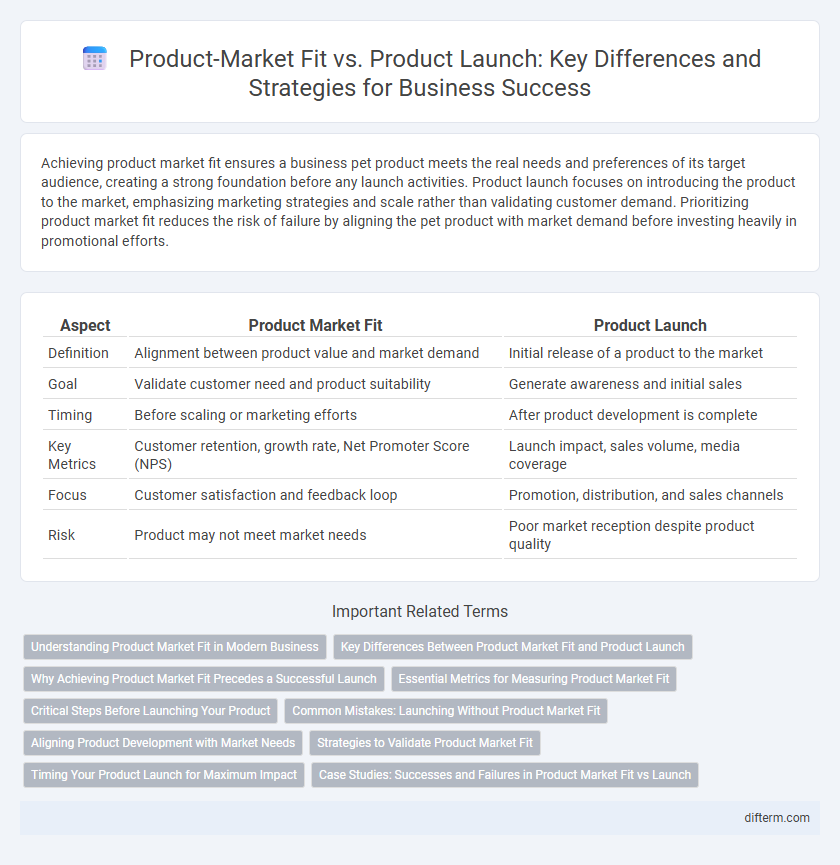Achieving product market fit ensures a business pet product meets the real needs and preferences of its target audience, creating a strong foundation before any launch activities. Product launch focuses on introducing the product to the market, emphasizing marketing strategies and scale rather than validating customer demand. Prioritizing product market fit reduces the risk of failure by aligning the pet product with market demand before investing heavily in promotional efforts.
Table of Comparison
| Aspect | Product Market Fit | Product Launch |
|---|---|---|
| Definition | Alignment between product value and market demand | Initial release of a product to the market |
| Goal | Validate customer need and product suitability | Generate awareness and initial sales |
| Timing | Before scaling or marketing efforts | After product development is complete |
| Key Metrics | Customer retention, growth rate, Net Promoter Score (NPS) | Launch impact, sales volume, media coverage |
| Focus | Customer satisfaction and feedback loop | Promotion, distribution, and sales channels |
| Risk | Product may not meet market needs | Poor market reception despite product quality |
Understanding Product Market Fit in Modern Business
Understanding Product Market Fit in modern business involves identifying a target audience's specific needs and validating that the product effectively solves these problems. Achieving product market fit requires continuous customer feedback, iterative development, and market analysis before a full product launch. Companies with strong product market fit experience higher customer retention, faster growth, and greater long-term success.
Key Differences Between Product Market Fit and Product Launch
Product Market Fit represents the stage where a product satisfies strong market demand, indicating verified customer validation and alignment with target audience needs. Product Launch involves the strategic introduction of the product to the market, emphasizing marketing campaigns, distribution channels, and initial sales efforts. Key differences lie in Product Market Fit focusing on product-market alignment and customer feedback, while Product Launch centers on market entry execution and brand awareness.
Why Achieving Product Market Fit Precedes a Successful Launch
Achieving Product Market Fit ensures a product meets genuine customer needs, validating demand before scaling efforts. Without this alignment, product launches risk poor adoption, wasted resources, and negative market reception. Securing Product Market Fit optimizes market entry strategies and maximizes revenue potential during the launch phase.
Essential Metrics for Measuring Product Market Fit
Measuring Product Market Fit requires analyzing key metrics such as customer retention rate, Net Promoter Score (NPS), and monthly recurring revenue (MRR) growth to determine product acceptance and user satisfaction. Engagement metrics like daily active users (DAU) and churn rate provide insights into user behavior and product value perception before a full product launch. Tracking these essential indicators ensures that the product meets market demands effectively, reducing the risks associated with premature scaling or launching.
Critical Steps Before Launching Your Product
Identifying product market fit involves rigorous customer research, validating demand through MVP testing, and iterating based on user feedback to ensure the product addresses real pain points. Prior to launching, it is crucial to develop a comprehensive go-to-market strategy, align cross-functional teams, and finalize sales and distribution channels. Securing product market fit minimizes market risks and maximizes launch success by ensuring the product resonates with target customers.
Common Mistakes: Launching Without Product Market Fit
Launching without achieving product market fit often leads to premature market entry, resulting in poor customer adoption and wasted resources. Many startups misinterpret early interest as validation, ignoring crucial product adjustments that align with market needs. Ensuring product market fit through iterative testing and customer feedback minimizes risk and maximizes the chances of a successful product launch.
Aligning Product Development with Market Needs
Achieving product-market fit requires continuous validation of customer pain points and iterative adjustments to the product based on user feedback. Product launch strategies should emphasize targeting early adopters who represent the ideal market segment discovered during development phases. Aligning product development with market needs ensures higher adoption rates and long-term business growth by minimizing market risks and maximizing customer value.
Strategies to Validate Product Market Fit
Validating Product Market Fit requires targeted strategies such as conducting in-depth customer interviews, analyzing user engagement metrics, and implementing Minimum Viable Product (MVP) tests to gather actionable feedback. Utilizing data-driven approaches like cohort analysis and Net Promoter Score (NPS) surveys helps determine genuine market demand and customer satisfaction levels. Prioritizing iterative product development based on real user insights ensures alignment with market needs before a full-scale product launch.
Timing Your Product Launch for Maximum Impact
Achieving product market fit before launching your product ensures alignment with customer needs, which significantly increases market acceptance and sales potential. Timing your product launch to coincide with peak market demand, such as industry events or seasonal trends, maximizes initial impact and customer engagement. Leveraging data-driven insights on user behavior and competitor activity optimizes launch timing, accelerating growth and reducing time-to-market risks.
Case Studies: Successes and Failures in Product Market Fit vs Launch
Case studies reveal that achieving product market fit (PMF) before launch significantly increases long-term success, as seen in Airbnb's iterative testing and user feedback cycle leading to exponential growth. In contrast, premature product launches without validated PMF, such as Google Glass, resulted in market rejection and costly pivots. Businesses that prioritize rigorous PMF validation demonstrate higher customer retention and scalability compared to those that rush to market.
Product Market Fit vs Product Launch Infographic

 difterm.com
difterm.com